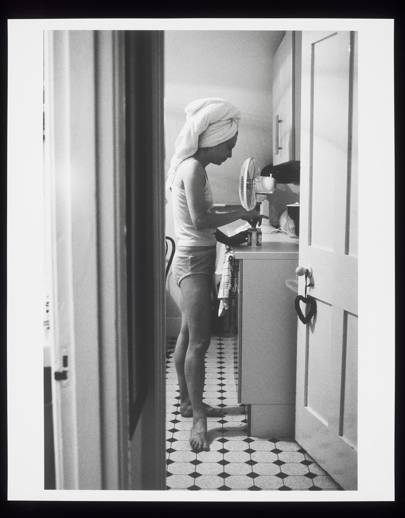The four prints from McCartney’s Off Pointe series capture ballet dancers going about their rituals backstage at the Royal Opera House. “They invited me into their world,” the artist tells Vogue of immersing herself in their lives in 2004, during a period when she found herself wandering around London searching for new projects. “We became friends. They wanted their story to be seen.”
This complete integration – she followed her main subject, Sian Murphy, everywhere – is in keeping with McCartney’s usual methodology. “My style has always been collaborative and about forming a relationship with my subjects,” she explains. “My passion is to show the private moments that go on behind the scenes to surprise and intrigue my viewers.” Accordingly, the dancers are captured smoking between acts, applying make-up and soaking their feet in baths, as McCartney acknowledges the gruelling preparation behind the moves they make look so effortless.
“The devotion and dedication and physical strength that it takes to be a ballet dancer at that level is immense,” McCartney shares of what intrigued her most about her subjects, who, she adds, are all close to each another.

Her decision to donate four of the 14 portraits to the museum is rooted in her admiration for the curators' research. “The Photography Centre shows the complete breadth of photography since it began,” she says of the offering that stems far beyond the inaugural display, Collecting Photography: From Daguerreotype to Digital, which Off Pointe sits within. And "the gallery is the most stunning setting to wander through and view the collections."

Though the V&A was one of the first museums in the world to collect and exhibit photographs – and now boasts a collection of 800,000 pictures and 6,000 historic cameras spanning the whole history of the medium – curator Susanna Brown believes that photography has never been more relevant as an art form. “Photography is a mirror onto the world, which means that photographic images often resonate with our personal experiences in a way that other art forms can't,” she notes. “Photography's enormous range of uses means it connects with us all on some level – it's a poetic and artistic medium as well as a science, a documentary device, an advertising tool and so on.
And for the Vogue reader, there will be many familiar names accompanying McCartney's on display. "From early masters such as Cecil Beaton and Edward Steichen to later stars like Gianni Penati and Irving Penn, many featured photographers have contributed to the magazine," Brown continues. What are you waiting for?

No comments:
Post a Comment